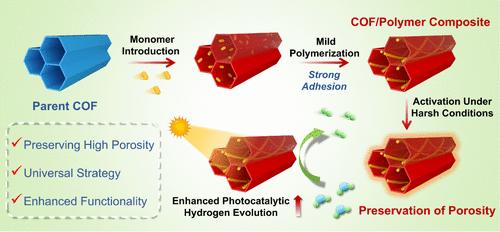Preserving High Porosity of Covalent Organic Frameworks via Functional Polymer Guest Introduction
IF 15.6
1区 化学
Q1 CHEMISTRY, MULTIDISCIPLINARY
引用次数: 0
Abstract
Due to their high structural tunability, remarkable internal surface areas, readily accessible pore space, and host of possible applications, covalent organic frameworks (COFs) remain at the forefront of materials science research. Unfortunately, many COFs suffer from structural distortions or pore collapse during activation, which can lead to a substantial loss of crystallinity and functionality. Thus, herein, we demonstrate a facile method to address this issue by introducing polymer guests. The polymer adheres to the COF internal pore wall, acting as a supporting pillar during activation and effectively preserving the COF porosity and crystallinity. In fact, the surface area of one COF/polymer composite, known as TAPB-TA/PDA, was boosted by a factor of 16 when compared to the parent COF, TAPB-TA. More importantly, the now robust COF structure was able to resist layer shifting and order loss during both solvent immersion and removal. The introduction of functional polymer guests not only solidifies the COF structure and preserves its high porosity but is also shown to enhance the transport and separation of photogenerated charge carriers, thereby facilitating hydrogen evolution during photocatalytic water splitting. Molecular dynamics simulations further support experimental observations that the incorporation of PDA within the COF pores reinforces the walls, preventing its collapse. The proposed mechanism is based on the adsorption of PDA oligomers along the c direction of the unit cell, fastening the COF layers in place via van der Waals interactions. This kind of interaction locks −N═CH–Ph–CH═N– units in a trans-configuration in the COF pores.

通过功能性聚合物客体保持共价有机框架的高孔隙率 简介
共价有机框架(COFs)具有结构可调性高、内表面积大、孔隙空间易获取以及应用广泛等特点,因此一直处于材料科学研究的前沿。遗憾的是,许多 COF 在活化过程中会出现结构扭曲或孔隙塌陷,从而导致结晶度和功能性的大量丧失。因此,我们在本文中展示了一种通过引入聚合物客体来解决这一问题的简便方法。聚合物附着在 COF 内部孔壁上,在活化过程中起到支撑柱的作用,有效地保持了 COF 的孔隙度和结晶度。事实上,一种名为 TAPB-TA/PDA 的 COF/聚合物复合材料的表面积与母 COF TAPB-TA 相比提高了 16 倍。更重要的是,现在坚固的 COF 结构在溶剂浸泡和去除过程中都能抵抗层移和阶次丢失。功能性聚合物客体的引入不仅固化了 COF 结构并保持了其高孔隙率,而且还增强了光生电荷载流子的传输和分离,从而促进了光催化水分离过程中的氢进化。分子动力学模拟进一步支持了实验观察结果,即在 COF 孔隙中加入 PDA 可加固孔壁,防止其坍塌。所提出的机理基于 PDA 低聚物沿单元格 c 方向的吸附,通过范德华相互作用将 COF 层固定在原位。这种相互作用将-N═CH-Ph-CH═N-单元以反式构型锁定在 COF 孔中。
本文章由计算机程序翻译,如有差异,请以英文原文为准。
求助全文
约1分钟内获得全文
求助全文
来源期刊
CiteScore
24.40
自引率
6.00%
发文量
2398
审稿时长
1.6 months
期刊介绍:
The flagship journal of the American Chemical Society, known as the Journal of the American Chemical Society (JACS), has been a prestigious publication since its establishment in 1879. It holds a preeminent position in the field of chemistry and related interdisciplinary sciences. JACS is committed to disseminating cutting-edge research papers, covering a wide range of topics, and encompasses approximately 19,000 pages of Articles, Communications, and Perspectives annually. With a weekly publication frequency, JACS plays a vital role in advancing the field of chemistry by providing essential research.

 求助内容:
求助内容: 应助结果提醒方式:
应助结果提醒方式:


